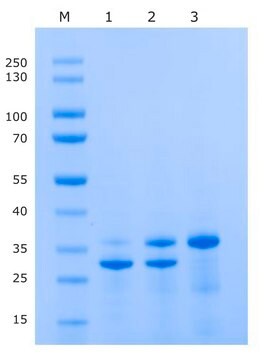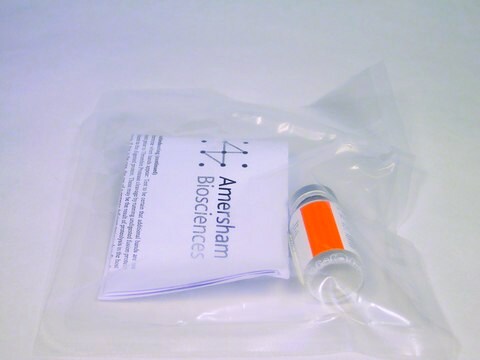SAE0067
SUMO Protease
His tagged recombinant protein, lyophilized powder
Sinónimos:
Small Ubiquitin-like Modifier Protease, ULP, Ubiquitin like protease, Ubiquitin-homology domain protein PIC1, Ubl-specific protease 1
About This Item
Productos recomendados
recombinant
expressed in E. coli
Quality Level
assay
≥95% (SDS-PAGE)
form
lyophilized powder
mol wt
27 kDa
shipped in
ambient
storage temp.
−20°C
General description
SUMO protease is active over a wide range of temperatures (2–30 °C), ionic strengths (0–400 mM NaCl), and pH ranges (6–8.5). However, its activity may vary depending on the substrate and conditions. Researchers will need to optimize their specific reaction conditions. As an initial suggestion, 20 units of SUMO protease can be used per mg of target protein for 1 hour at 30 °C, or overnight at 2–8 °C. The cleavage efficiency can then be estimated by SDS-PAGE. If necessary, the amount of SUMO protease can then be adjusted. SUMO protease works better in the presence of reducing agents, e.g., 0.5–2 mM DTT. DTT in the reaction mixture can significantly enhance cleavage efficiency, especially during longer incubations
Store the reconstituted product at –20 °C. It is recommended to reconstitute the enzyme in 100 μL of either water or 50% glycerol (v/v), supplemented with 1 mM DTT. Solutions in water/DTT should be stored in frozen aliquots to avoid freeze-thaw cycles, which can adversely affect the protease activity.
Unit Definition
Storage Class
11 - Combustible Solids
wgk_germany
WGK 2
flash_point_f
Not applicable
flash_point_c
Not applicable
Certificados de análisis (COA)
Busque Certificados de análisis (COA) introduciendo el número de lote del producto. Los números de lote se encuentran en la etiqueta del producto después de las palabras «Lot» o «Batch»
¿Ya tiene este producto?
Encuentre la documentación para los productos que ha comprado recientemente en la Biblioteca de documentos.
Los clientes también vieron
Nuestro equipo de científicos tiene experiencia en todas las áreas de investigación: Ciencias de la vida, Ciencia de los materiales, Síntesis química, Cromatografía, Analítica y muchas otras.
Póngase en contacto con el Servicio técnico






